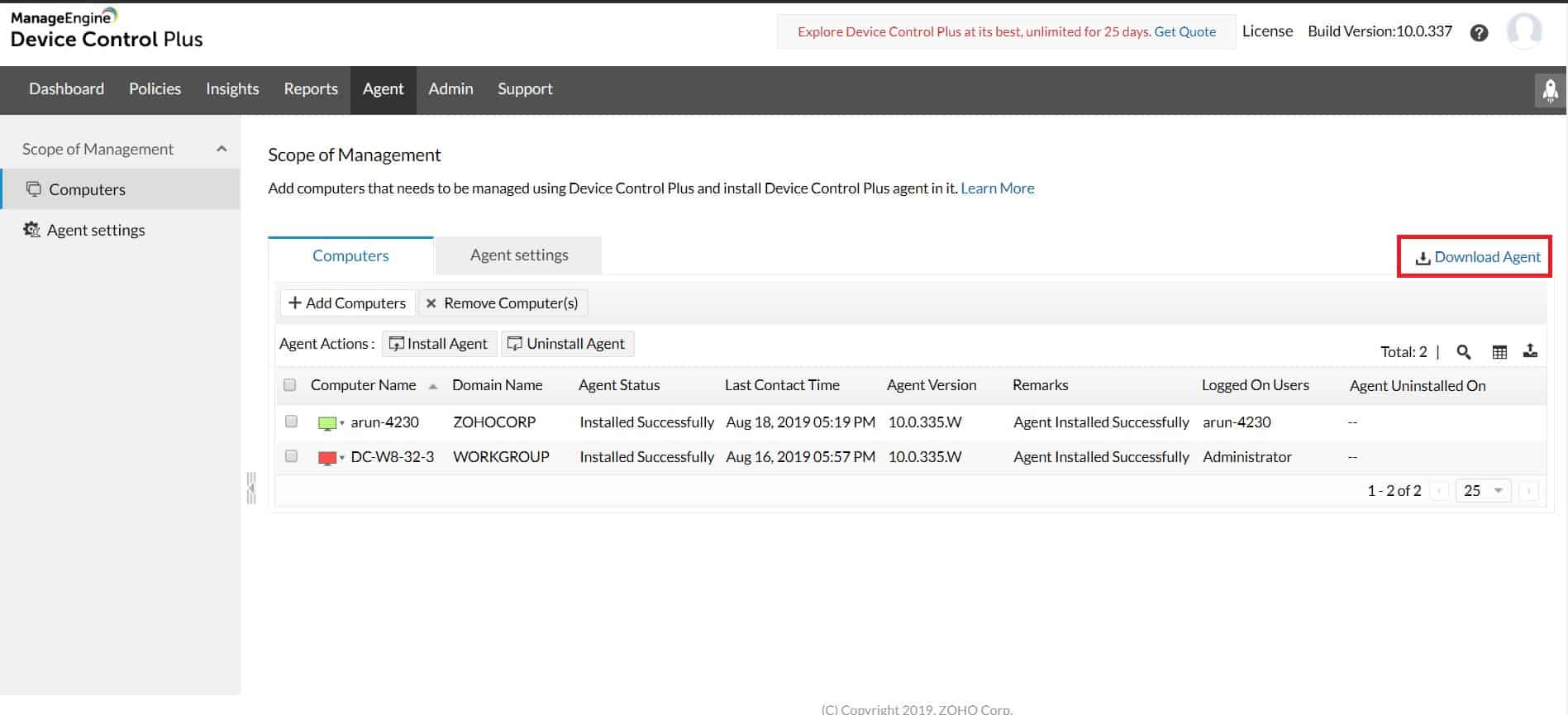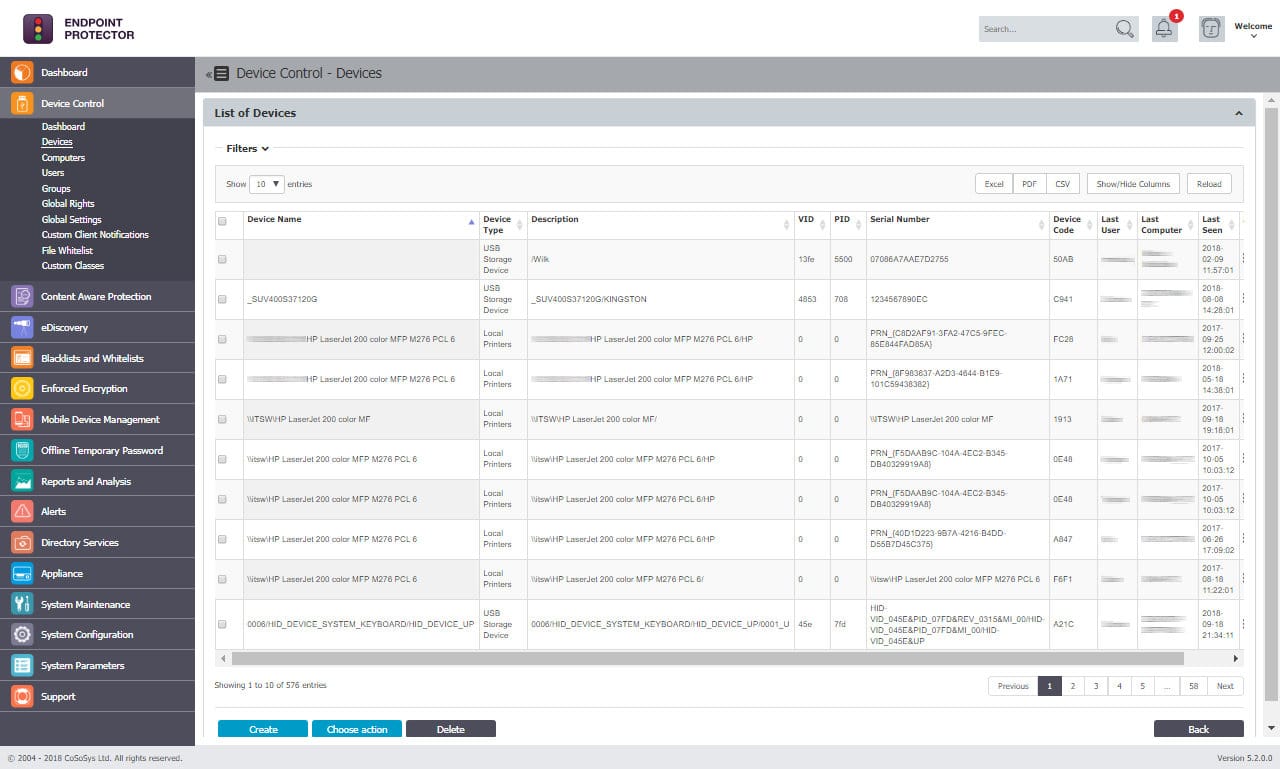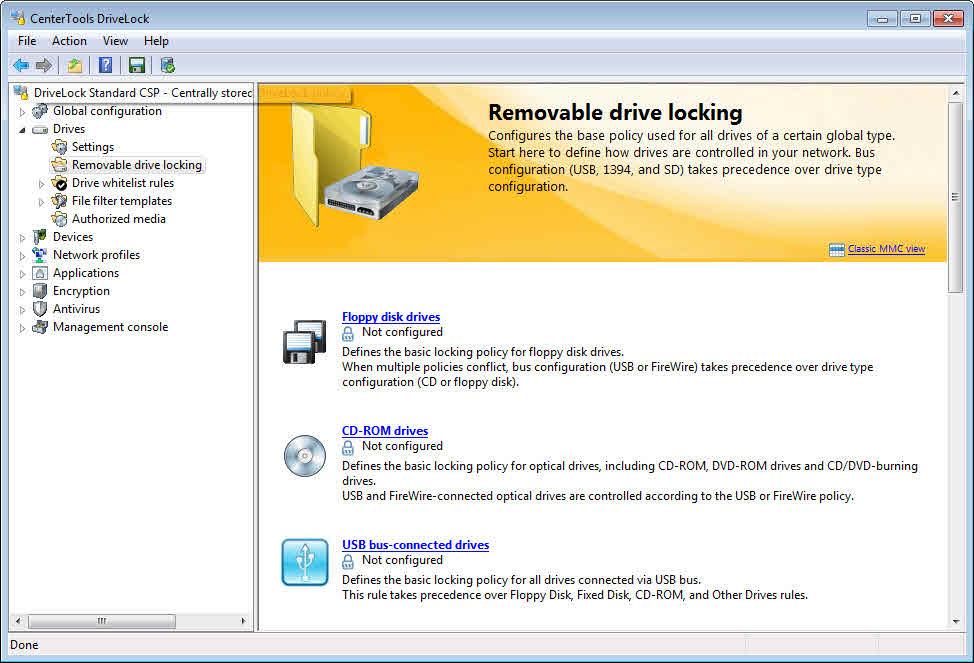USB flash drives are storage devices much smaller in size and used by most customers and businesses for managing backup and storing confidential data. These miniature hard drives can be easily scaled and are less expensive. Further, users don’t require any form of internet connection to transfer or exchange files from one system to another.
Here is our list of the best tools to protect USB firmware:
- ManageEngine Device Control Plus: A comprehensive solution for controlling and monitoring USB traffic, with automated device blocking.
- CoSoSys Endpoint Protector: Offers detailed reporting and analysis tools, eDiscovery, and file tracing for effective USB protection.
- DriveLock: Notable for its device encryption and extensive forensic analysis, offering a multi-layered security approach.
These are lightweight and highly portable. With so many advantages, there are also a few disadvantages one must take care of. USB devices have a high chance of infecting viruses or malware. If a system is malware-infected, there are good chances that you could easily transfer the virus to your drives.
Hence, to help protect your USB Firmware from Viruses, we have listed a few tools and methods that may prevent the virus from getting infected and causing damage to your data. Further, we have shared a few security challenges that most consumers and businesses face and must take proper care of.
All You Need to Know About USB Drive Malware
USB drives have been in use for the past 20 years and more. Many people across the globe use USB drives to maintain backups, for auxiliary storage, and to transfer data between two systems/computers. In simple words, small USB sticks or devices are an easy and convenient mode to exchange and transfer data from one system to the other.
Even people who are not digitally connected can take advantage of USB drives and share information from one system to the other. On one side, these miniature hard drives are considered compact and easy to use. On the other side, they have a high risk of getting attacked by cybercriminals.
As per old reports, cyber attackers have been targeting USB devices to infect systems for a long time. In 2010, Stuxnet, a malicious computer worm, was discovered, designed to target supervisory control and data acquisition systems. It was used by attackers to manipulate valves on the centrifuges responsible for enriching uranium gas. Instead of stealing data, attackers used it to inflict physical destruction on equipment controlled by computers.
These miniature hard drives are still in use and can be infected with malware, which attacks your business systems as soon as the device is connected. Since most USB drives are used for storing and transferring data, there is a greater security risk.
USB Malware Security Challenge
Data security of USB drives continues to be a big challenge for most consumers and businesses. Even after implementing various tactics to detect and block incoming threats, USB drives continue to be at great risk.
Each time a user plugs a USB drive into an unprotected computer system, a cybercriminal can easily make a way for your data. A virus may also be embedded into what appears to be a regular file on a USB drive, so even with AutoRun turned off, a computer will become infected if that file is opened.
While USB drives are merely chips on a stick, if used in malicious ways, they can carry malware, steal sensitive data, and trigger other malicious attacks. Also, if you are using your USB drive to move files between multiple host devices, this could leave you susceptible to malware.
No matter how many tactics you apply to safeguard your system or data, you may encounter the danger of contracting a malware infection if the system does not support antivirus software or does not scan USB drives after plugging into the system.
How Malware can affect USB Devices?
Malicious actors have the ability to stealthily infect computers with malware using USB devices, running a payload once a USB device is connected. Attackers often use USB devices as a mode of transmission to infect the system and computer files.
Similarly, an infected computer may transmit a virus onto the clean USB thumb drive inserted. That USB drive then spreads the virus to other computers, as long as the operating systems in those machines have a “Run”-type function enabled.
Simply plugging a device into the USB ports won’t help attackers achieve their purpose. In order to make the virus spread, it needs to be active in the system. First and foremost, on connecting the device to the ports, the viruses exploit the autorun function to spread.
Later, the virus-infected drivers infect other files and stop all functions.
A virus may include malicious code that attacks all system files and disable the ability to communicate with connected ports.
In addition to USB drives being used to carry the payload, drives can be as easily infected when placed into compromised computers. A computer can get infected with not just a USB thumb drive, but also with any device connected through the USB port, like a keyboard, mic, or mouse.
Flash drives are not the only culprits; any device plugged into a USB port – including gadgets like lights, fans, speakers, toys, and even digital microscopes – can be used to spread malware.
How to Protect Your USB Device?
Most people use USB drives to transfer files from one system to the other, unknown to the fact that it can make you vulnerable to malware. Hence, one needs to be very careful when inserting these miniature hard drives into unknown systems as they might infect viruses or malware.
Once you plug the device into the host network, it will hardly take a few seconds to infect a virus. USB drives are the root of virus propagation. Hence one needs to follow the right approach to secure USB flash drives.
It can be any type of malware, such as ransomware or silent malware. In all cases, infecting a virus can cause huge damage to your business. It leads businesses to learn how to protect their USB devices before it gets too late.
Before we continue further, let me tell you if you are using USB drives to manage confidential files, or sensitive data make sure to be cautious when it comes to USB security. It doesn’t work like an email virus, instead, it uses USB ports as a way to spread and infect other systems.
Here are a few methods that can work in your favor and protect your USB devices from getting infected by viruses:
- Secure USB Device In case, you are using a single personal flash drive, we recommend upgrading it. You can find many encrypted flash drives online that are more resistant to malicious modifications and prevent automated infection. Flash drives with 128-bit AES hardware encryption are the best ones as they reduce the risk of getting infected and prevent systems from being hacked. Also, there are a few flash drives that require a user to physically enter a password before accessing the data stored in it. This type of solution doubles up your security and reduces the possibility of software infections. Hence, make sure to invest in USB drives with built-in security features.
- Disable Autoplay Changes to the Autoplay feature can affect your network security. They are the most dangerous vulnerabilities, and attackers often target them to execute programs that may cause damage to your entire network. Sophisticated criminals have the ability to bypass it. Hence, it is recommended to disable the function to prevent the virus from spreading into the network and systems.
- Don’t Use Unknown USB Devices If the USB device does not belong to you, avoid plugging it into your system without scanning it. People often take flash drives to work or school and plug them into different systems. Indirectly, they infect the virus or malicious content in their drives. However, this issue has been reduced to a great extent as more and more people are now aware of the dangers of plugging in wild USB devices. But still, you must keep the point in mind and consider avoiding plugging in unknown USB devices. Be cautious of unknown peripherals and make sure to educate your surroundings about the danger of inserting random devices into your USB ports.
Our methodology for selecting the best tool to protect USB firmware
We’ve broken down our analysis for you based on these key criteria:
- Effectiveness in blocking unauthorized USB devices and data transfers.
- Detailed reporting and analysis capabilities for monitoring device usage.
- User-friendly interfaces for ease of management.
- Advanced security features like encryption and eDiscovery.
- Compatibility with various enterprise environments.
The Best Tools to Protect USB Firmware
Have a look at some of the top tools that an enterprise can invest in to protect USB firmware from getting infected. Compare and select the one that lies within your budget and fulfills basic requirements.
1. ManageEngine Device Control Plus – FREE TRIAL
Device Control Plus by ManageEngine helps businesses control and monitor network traffic running between endpoints and USB flash drives. Further, it detects and immediately blocks USB access across your network on noticing any suspicious activity or malware. Reduce insider threats and monitor hack attempts with the comprehensive device control and file access management solution.
Key Features
- Device Control Users can control all ports and prevent unauthorized access to their data. Further, it helps keep an eye on all device and file movements.
- File Access Control With Device Control Plus, administrators can set file access permission and restrict visibility to only those users they trust. Users may only be permitted to see or transfer a certain amount of data, depending on their reliability and intended use.
- Generates in-depth insights and reports Device Control Plus highlights all the suspicious devices, updates on the actions performed, device usage, and security events. Users can even generate insightful reports on a daily, monthly, or weekly basis as per their choice.
- Automated Device Blocking If any device violates security policies, the tool automatically blocks it. Users no longer need to manually check and look after each device with ManageEngine Device Control Plus.
Why do we recommend it?
In the face of mounting device-based threats, ManageEngine Device Control Plus is an invaluable tool for administrators tasked with protecting their networks. The automatic device blocking and granular controls over ports set this tool apart, allowing for customized filtering and security automation.
Another feature that makes ManageEngine Device Control Plus a good solution for USB firmware protection is it grants temporary access only upon making a request and blocks all unauthorized USB access.
Who is it recommended for?
Businesses of all sizes can benefit from Device Control Plus, especially those with sensitive information and many employees. Organizations with complex IT environments and varied device interactions would find this particularly beneficial.
Pros:
- Constantly scans all endpoints and notifies when a device is connected
- Prevents data leakage and blocks unauthorized devices
- Tracks and manages the different peripherals connected to endpoints
- Offers granular data movement controls to track hack attempts
- Controls all ports and permits access only upon making a request and for a limited period
Cons:
- Does not support sensitive data discovery
- Does not classify confidential data
EDITOR'S CHOICE
ManageEngine Device Control Plus is our top network monitor because it offers an unparalleled level of control and security for businesses dealing with USB devices. Its ability to automatically block devices that violate security policies and provide in-depth insights makes it an indispensable tool for any organization. The granular control over file access and device usage ensures that sensitive data is kept secure, while the comprehensive reporting features allow for easy monitoring of network traffic. It’s particularly beneficial for businesses with complex IT environments or those handling sensitive information.
Download: Download a 30-Day Free Trial
Official Site: https://www.manageengine.com/device-control/
OS: Windows, Linux, macOS
2. Endpoint Protector by CoSoSys
Endpoint Protector by CoSoSys is another trusted solution used by enterprises to prevent networks from malicious USB firmware-based attacks. It is cross-platform with a simple web-based interface that helps control and monitor all USBs and peripheral ports.
Key Features
- Detailed Report and Analysis It contains an integrated reporting and analysis tool that assists in keeping track of all activities pertaining to the use of the device or file transfers. Users can also export reports and logs via this tool.
- File tracing It assists in tracing all online file transfers and cloud services, giving users a clear picture of each operation.
- eDiscovery This feature helps protect sensitive data by performing scanning on a regular basis and maintaining regulatory compliance.
Why do we recommend it?
CoSoSys Endpoint Protector offers a robust mechanism to curb unauthorized access to storage devices. Its proactive approach, where it instantly blocks and reports any unauthorized access, gives it a definitive edge. The tool’s capability to trace all file transfers and cloud services operations, combined with its eDiscovery feature for regular data scanning, sets it apart.
Further, it is a centrally-managed Device Control module that provides full control over connected storage devices. Users can prevent all data leaks and protect their endpoints from known and unknown USB malware and threats using its advanced features.
The lightweight agent installed on the system instantly blocks unauthorized USB access and reports the administrator about the same. Apart from protecting the system from USB propagated malware, the Endpoint Protector also reduces instances of accidental or intentional data loss.
Who is it recommended for?
Given its extensive features, Endpoint Protector suits businesses of all scales, especially those dealing with sensitive data. Enterprises needing compliance with various regulations like HIPAA, PCI-DSS, and GDPR would particularly benefit from it.
Pros:
- Maintains security of your critical data and prevents malicious insider threats
- Uses advanced technologies to monitor and manage transfers
- safeguards any Personally Identifiable Information (PII) that may be saved on several endpoints
- Manages HIPAA, PCI-DSS, GDPR, SOX, and other legal compliance
- Supports multiple languages, including French, Spanish, German, etc.
Cons:
- Source code detection needs attention and improvement
- No protection for third-party-developed apps
3. Drivelock
DriveLock is a cloud-based endpoint security tool that protects the company’s data, devices, and systems from USB-based malware infection. It supports inbuilt file encryption and antivirus features that secure your crucial data at all times. Further, it offers multi-layered security and restrictions on different removable storage devices, including flash drives.
Key Features
- Device encryption Drivelock automatically encrypts all the USB media to protect highly sensitive data. With device encryption, the USB devices and stored data are secure, i.e., no one can access or tamper with them.
- Runs extensive forensic analysis and reporting The tool uses a wide range of technologies and methods to identify security threats and run detailed investigations. Forensic analysis involves collecting data from multiple sources and running in-depth analysis. Based on the analysis, the tool generates a report in a clear and concise manner with recommendations.
- Tracks all operations Users can easily track and visualize the sequence of events as well as identify any suspicious or malicious actions via the console. The tool creates a comprehensive timeline view of all activities and operations that take place on the system.
Why do we recommend it?
DriveLock’s forte lies in its proactive encryption approach, ensuring all USB media remains inaccessible and untampered. Integrating forensic analysis and reporting facilitates early threat identification and rigorous investigation, making this tool a powerhouse for proactive defense.
Who is it recommended for?
DriveLock is ideally suited for businesses that emphasize data integrity, especially when reliant on a host of external devices. Given its ease of setup and cloud data hosting, it is a favorable choice for organizations looking to manage security with minimal infrastructural changes.
Pros:
- Helps watch over all internal and external connected devices
- There is no need for any extra third-party software with Drivelock
- Easy to manage and set up security profiles while hosting data in the cloud
- Runs an extensive forensic analysis and automatically protects external USB data carriers via encryption
- Monitors every single file that is being copied from one place to the other
Cons:
- Not an ideal option for non-technical viewers
- Lacks a few advanced features






